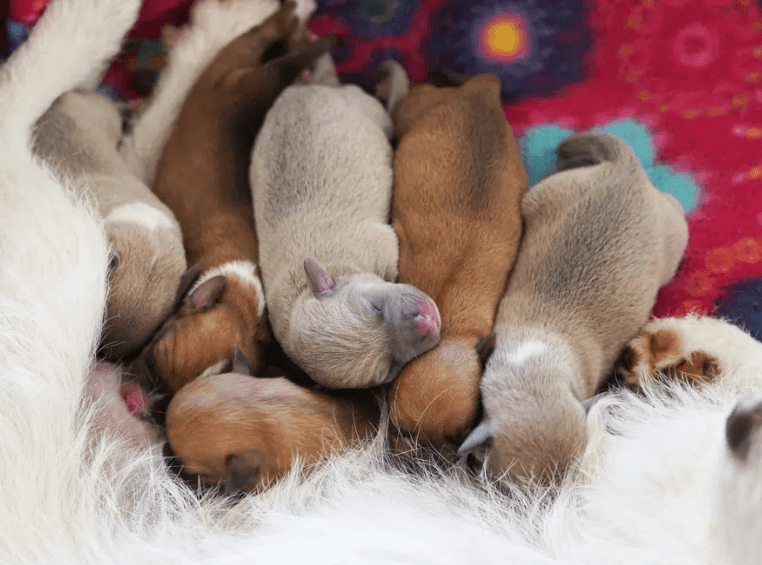
Can Puppies Have Different Fathers? 2025 Vet Guide to Superfecundation in Dogs & Multi-Sired Litters
Hey there, dog lovers! 🐾 Ever stared at a litter of puppies and thought, “Wait… why does that one look like a Mini Poodle and the other like a Great Dane?” You’re not imagining things! Let’s unravel the wild world of superfecundation—where one litter can have multiple dads. Buckle up, because nature’s got some surprises!

The Short Answer: Yes, Puppies Can Have Different Dads
Here’s the scoop: If a female dog mates with multiple males during her heat cycle, each pup in the litter could technically have a different father. This phenomenon, called superfecundation, is rare in pampered pets but shockingly common in stray dogs (and cats!). Think of it as nature’s “mix-and-match” game.
Fun fact: While it’s extremely rare in humans (only 1 in 400 twin cases!), animals like dogs, cats, and even cows pull this off regularly.
How Does It Work? Let’s Break It Down
1️⃣ Heat Cycle Hijinks: Female dogs release multiple eggs over 24–48 hours during ovulation. If they mate with different males in this window, sperm from each can fertilize separate eggs.
2️⃣ Sperm Survival Race: Dog sperm can live up to 11 days in the reproductive tract! This means even mates days apart can contribute to the same litter.
3️⃣ DNA Detectives: The only way to confirm multi-sired litters? DNA tests. One study found 15% of stray dog litters had multiple fathers.
Pro tip: If your pup’s siblings look like they’re from different planets (fluffy vs. sleek, spotted vs. solid), you might have a superfecundation situation!
Why Does It Happen? Blame Biology!
• Stray Dog Drama: Unspayed females roaming freely often mate with multiple males, increasing genetic diversity (and survival odds) for the litter.
• Breeder Surprises: Even controlled breeding can go sideways if a female escapes and “collects” extra suitors mid-cycle.
• No Harm, No Foul: Superfecundation itself isn’t dangerous, but mismatched dad sizes (e.g., Chihuahua + Mastiff) can risk birth complications.
Real-life example: A 2023 study of 200 stray litters in Brazil found 11% had 2+ fathers—some pups inherited one dad’s stubby legs and another’s wolf-like coat.
Can You Prevent It?
✅ For Pet Owners:
• Keep females isolated during heat (no “oops” romances!).
• Schedule single-sire matings with trusted breeders.
🌍 For Strays:
• Support spay/neuter programs—the only surefire way to curb surprise litters.
Myth busted: Letting a female “pick her mate” doesn’t guarantee one dad. Biology doesn’t care about canine crushes!

Wild Comparisons: It’s Not Just Dogs!
• Cats: 1 in 3 stray cat litters have multiple dads.
• Humans: A 2024 case in Vietnam made headlines when twins had different fathers—proven by DNA tests.
• Rodents: Mice and rats? Superfecundation pros. Evolution loves a genetic gamble!
The Takeaway
Superfecundation is nature’s quirky way of keeping gene pools fresh. While your golden retriever’s pups probably share one dad, strays are rocking the multi-parent trend. Curious about your pup’s pedigree? At-home DNA kits like Embark can solve the mystery!
PSA: Spay/neuter saves lives—and prevents paternity puzzles! 🐶❤️
Note: Always consult your vet for breeding advice. When in doubt, DNA doesn’t lie!
American Dingo animal behavior Budget Tips canine behavior Canine Care Canine Health DIY pet projects dog behavior Dog Breeds dog care Dog Care Tips dog exercise Dog Food Dog Grooming dog health Dog Measurement dog nutrition dog ownership dog potty area Dog Training Dog Wound Care Family Pets Hunting Dogs lipomas in dogs newborn puppy care obedience training outdoor pet care Pet Care Pet Care Tips Pet Health Pet Loss Pet Safety pet tips pet training Positive Reinforcement Potty Training Puppy Care puppy health Puppy Training Rabies in Dogs Temperature Monitoring Training Tips veterinary advice Veterinary Care Veterinary Tips
Sorry. No data so far.
Leave a Reply
You must be logged in to post a comment.